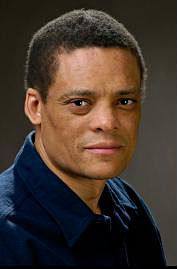You might expect singing when attending an event featuring the Cosmic Tenors. But that would be trite—after all, who has time for singing when you’re discussing the teleportation devices from Star Trek? It’s just one of the many questions the Tenors, a trio of physicists, have fielded during their far-reaching lectures. Their discussions are meant to expose a broad audience, from lay to expert, to various scholarly perspectives. The audience is then free to grill them on anything from string theory to the USS Enterprise.
The Cosmic Tenors is made up of Larry Gladney, Professor of Physics and Astronomy and chair of the department; Herman White, an experimentalist and part of the Fermi National Accelerator Laboratory; and James Gates, a theorist from the Center for String and Particle Theory at the University of Maryland. The group saw its genesis following a well-received talk they gave at a National Society of Black Physicists forum, and when a colleague in attendance approached them with the idea of the Cosmic Tenors, they were intrigued.
“It was both an exhilarating and terrifying time. Bedrock facts that define the way the universe behaves, fundamentals like quantum mechanics or general relativity, suddenly had these kinks in their armor.” – Larry Gladney
Gladney came to Penn as a post-doc. He was drawn to the University in part because of the exciting new Collider Detector at Fermilab project, an experimental particle physics collaboration that boasted the kind of multi-disciplinary expertise essential to creating a successful high energy physics team. In 2001, he was tasked with completing the first-ever roadmap to U.S. high-energy physics research. The field was going through a shake-up due to the discovery of dark energy, an enigmatic force responsible for causing the universe to expand. Physicists were suddenly being asked to rethink the realities of the universe. Gladney, who was working with high-energy accelerators at the time, took a sabbatical to immerse himself in astrophysics.
“It was both an exhilarating and terrifying time,” says Gladney. “Bedrock facts that define the way the universe behaves, fundamentals like quantum mechanics or general relativity, suddenly had these kinks in their armor because they didn’t neatly describe dark energy. We were faced with conditions that couldn’t be mimicked inside of any laboratory. On the flipside, it meant making room for new and exciting theorizing.”
It’s this new age of enlightenment that fuels the Cosmic Tenors’ discussions. James Gates, the theorist of the group, introduces audiences to everyday, observed physics, weaving in themes from quantum mechanics and special relativity. Herman White, an experimentalist like Gladney, expands on these themes using his background in particle physics, and finally, Gladney uses his astrophysics background to discuss particle cosmology—all things related to high energy physics and its role in the early universe.
“We’ve all given public lectures, but never in this format,” Gladney says. “We actually get some really tough questions. It gives me a chance to reflect on why physics was so attractive to me in the first place. I grew up enamored with the Apollo program and Star Trek. The question asked by any good science fiction series is: how is the world going to turn out in the future, and how do we make sense of it? It’s what drives physicists each and every day.”
Gladney has since taken on the role of chair of the department, in addition to teaching. He is responsible for securing funding for groundbreaking new projects like Penn’s construction of a Large Synoptic Survey Telescope (LSST). The technology focuses on recording data from large chunks of space. This has proven difficult in the past because unlike normal telescopes that look at a fairly narrow area, the LSST requires huge amounts of storage space—an estimated one Blu-ray DVD every five minutes.
As far as reviewing that much data, Gladney laughs, “It’s like finding a needle in a haystack full of needles.”



